




How to Identify and Solve Problems on Lines and Shapes
Line and Line Segment
In geometry, it is usual to suggest that a segment and a line are the same thing. A segment has a start and an endpoint, and each end is shown by a point. Segments involve the length of a table, the length of a straight road, and so on. A line, on the other hand, has no distinct beginning or endpoint. A segment is a component of a line, but a line is not a component of a segment.
Definition of Shapes
Geometrical forms are figures that represent the shapes of various items. Some figures are two-dimensional, while others are three-dimensional. Two-dimensional figures have only the x and y axes, but three-dimensional forms have the x, y, and z axes. The z-axis represents the object's height.
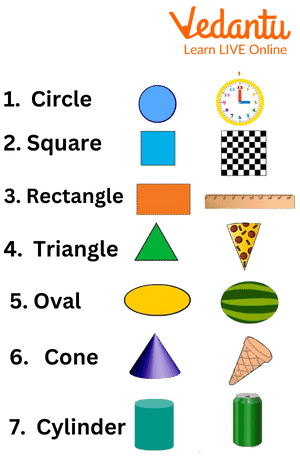
Shapes Name With Example
Define a Line
A line is a one-dimensional linear figure that stretches in opposing directions endlessly. A line is a figure produced by connecting two points with the shortest possible distance between them and extending both ends to infinity. A line can be either horizontal or vertical in orientation. It can be drawn from the left to the right or from the top to the bottom.
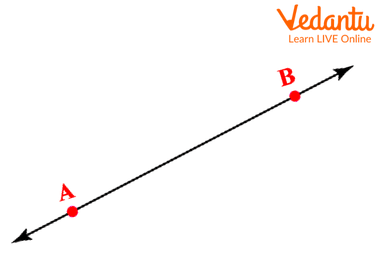
Line Drawn Between Point A And B
Types of Lines
There are different types of lines based on the operation performed on them.
Parallel lines are defined as two lines that run in the same plane but never intersect. Alternatively, if two lines do not overlap at any point, they are considered to be parallel lines.
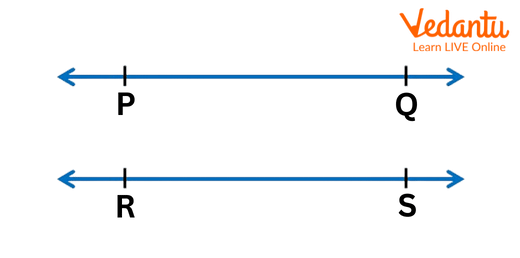
Line PQ Is Parallel To Line RS
Intersecting Lines - Two lines that intersect at a place are considered to be intersecting lines. Perpendicular lines are those generated when two intersecting lines meet at a right angle. If the angle formed by two lines is a right angle, they are perpendicular to one another.
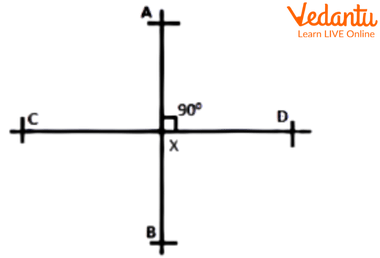
Line AB Intersects Line CD at Right Angle
Transversal Line - A transversal line is one that connects two parts of lines at separate locations. A transversal line intersects two lines at points P and Q in the figure.
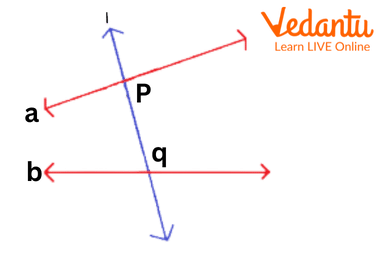
Transversal Line
Lines and Shapes Drawing
To draw any shape using lines we need to follow certain steps. Begin drawing or designing any of the figures with a line, a line segment, or a curve. Different sorts of forms and figures result from the number and arrangement of these lines, such as a triangle, a figure with three line segments joined, a pentagon (five line segments), and so on. If the lines are not joined together then the shape formed is called an open figure.
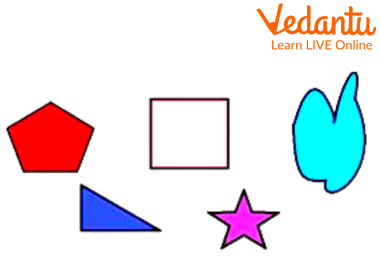
Shapes Formed After Joining Different Lines
Conclusion
A segment is a part of a line where the line can extend from one point to the other. In this unit we learnt about different types of lines and shapes. We also learnt how we can draw different shapes using the lines and line segments.
Sample Questions
1. The given image indicates
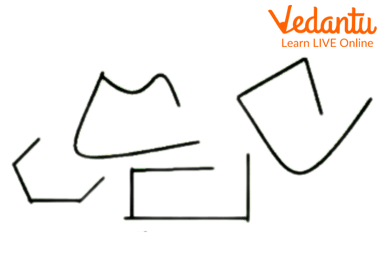
Open Figures
a. Open figures
b. Closed figures
c. None of the above
d. Both a and b
Ans: Open figures
Explanation: The given image has open figures because the figures having different line segments are not joined to each other, making them incomplete figures.
2. How many angles can be formed if two lines are parallel lines?
a. Infinite
b. 360
c. 90
d. 0
Ans: 0
Explanation: Zero or no angles will be formed between the parallel lines as these lines do not intersect each other. And angles are formed only between the intersecting lines.
3. A line segment which can be extended from only one direction is called
a. Ray
b. Line segment
c. Transversal lines
d. Perpendicular line
Ans: Ray
FAQs on Lines and Shapes: Concepts, Properties & Examples
1. What are lines and shapes in Maths?
In basic Maths, a line is a straight or curved mark that connects two points. A shape is a closed figure, like a square or a circle, that is formed by connecting lines or curves. Lines are the building blocks used to draw shapes.
2. What is the main difference between a line and a shape?
The main difference is that a line is a path that can be open, while a shape is always a closed area. You use lines to create the boundary or outline of a shape. For example, four straight lines joined together can form the shape of a square.
3. What are the basic types of lines a student learns in early classes?
In early classes, students primarily learn about four basic types of lines:
- Standing Lines (Vertical Lines): Lines that go straight up and down.
- Sleeping Lines (Horizontal Lines): Lines that go straight from left to right.
- Slanting Lines: Lines that are tilted and are neither vertical nor horizontal.
- Curved Lines: Lines that are not straight and have a bend.
4. How do simple lines help in forming different shapes?
Lines form shapes when they are connected end-to-end to enclose a space. The number and type of lines determine the shape. For instance, joining three straight lines creates a triangle, while joining four equal straight lines at right angles makes a square. A single, continuous curved line can form a circle.
5. Can you give some examples of basic shapes found in everyday objects?
Yes, you can find basic shapes everywhere. For example:
- A wall clock or a plate is often a circle.
- A mobile phone screen or a book is a rectangle.
- A slice of pizza or a sandwich cut diagonally is a triangle.
- A checkerboard has many squares.
6. What is the difference between horizontal and vertical lines?
A horizontal line is a line that runs from left to right or right to left, like the horizon where the sky meets the sea. It is also called a sleeping line. A vertical line is a line that runs from top to bottom or bottom to top, like a tall tree or a flagpole. It is also called a standing line.
7. Why is it important for students to learn about lines and shapes?
Learning about lines and shapes is crucial because it forms the foundation of geometry. It helps students understand the world around them by identifying objects and their properties. This knowledge is also essential for developing skills in drawing, writing, and problem-solving.
8. What is a pattern and how can we create patterns using lines and shapes?
A pattern is a sequence of objects, lines, or shapes that repeats in a logical way. You can create simple patterns by alternating between different shapes (e.g., Circle, Square, Circle, Square...) or by repeating a sequence of lines (e.g., Vertical, Horizontal, Vertical, Horizontal...).
9. What makes a shape symmetrical?
A shape is symmetrical if you can draw a line through it (called a line of symmetry) and divide it into two identical halves that are mirror images of each other. For example, a circle and a square are symmetrical. However, shapes like a scalene triangle (with all sides of different lengths) are not symmetrical because they cannot be divided into two identical halves.











